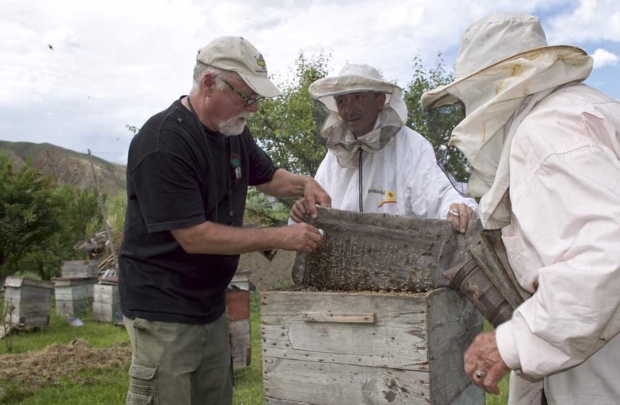
Washington State University entomologists Steve Sheppard, left, collects pomonella bee specimens in 2015 in the Tien Shan Mountains of Central Asia. Courtesy Steve Sheppard
From high in the Tien Shan Mountains of Central Asia, Washington State University entomologists Steve Sheppard and Brandon Hopkins have brought home semen from a new strain of honeybees that evolved right alongside the wild apple tree.
Using cryogenically preserved genetic material, Sheppard and his team of specialists at the university’s bee laboratory in Pullman, Washington, are using the semen to “back breed” with other strains of honeybees already in the United States to get as close as they can to pure Apis mellifera pomonella, a honeybee subspecies. So far, they have reproduced bees that are 75 percent A. mellifera pomonella; they plan to continue to achieve a higher percentage.
The project aims to help the bee program further boost genetic diversity and give queen producers in California more options when breeding for different traits. They also are keeping some of the semen in the world’s first honeybee germplasm repository, also in Pullman.
Sheppard has asked for $3,000 in additional funding from the Washington Tree Fruit Research Commission to continue back breeding work. This follows an original grant of $10,000 that allowed Sheppard and Hopkins to locate, collect and return the genetic material from Central Asia to eastern Washington in 2015.

Using a chicken coop as a makeshift laboratory, Washington State University entomologist Brandon Hopkins collects pomonella bee semen in 2015 in the Tien Shan Mountains of Central Asia. Courtesy Steve Sheppard
The university’s bee team has done lots of breeding already, using Italian, Carniolan and Caucasian honeybees. Throwing another strain into the mix just increases the stock of genetic material.
However, this bee — called the Tien Shan Mountain Grey Bee by locals in its native home — offers an interesting twist. It evolved in the same geographic location as the apple itself, where apple breeders visit to collect seeds from wild apple forests. That’s why the WSU entomologists gave it the scientific name A. mellifera pomonella.
“It kind of makes sense that maybe a bee that co-evolved with apples in its homeland may be a good apple pollinator,” Sheppard said.
Sheppard has been courting bees from mountainous regions of the former Soviet Republics of Kazakhstan and Kyrgyzstan for more than a decade. In 1999, he first visited Central Asia, hiking steep mountain trails and driving endless dirt roads, to work with local beekeepers and nature preserve rangers to collect specimens that he and his colleagues later identified through morphological and DNA analysis as a unique subspecies, completely different than the strains already in the United States and any other bee previously known to science.
In 2008, the university’s bee breeding program received a special permit from the U.S. Department of Agriculture to import honeybee semen. The U.S. has had a ban on importing live bees since 1922.
The researchers not only believe they will improve genetic traits for beekeepers and fruit growers, but they could help safeguard the very survival of the pomonella bees.
“It’s a safety net for the future and stability for that population,” Hopkins said. •






Leave A Comment